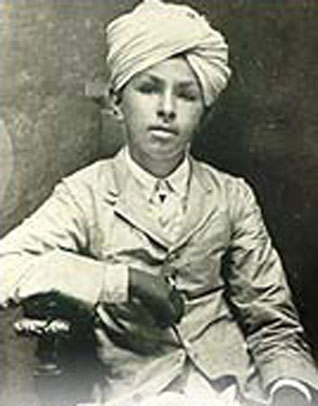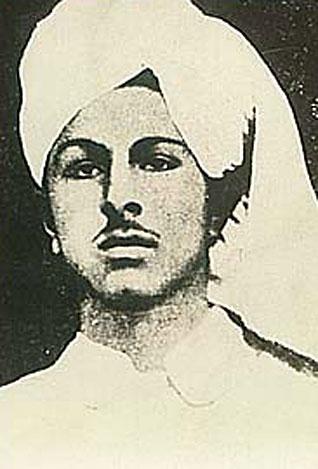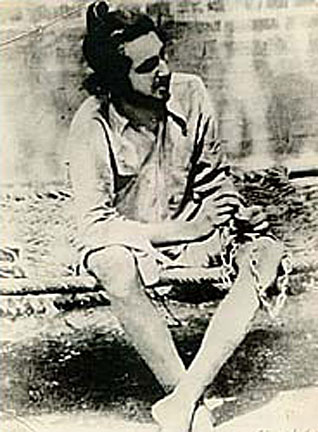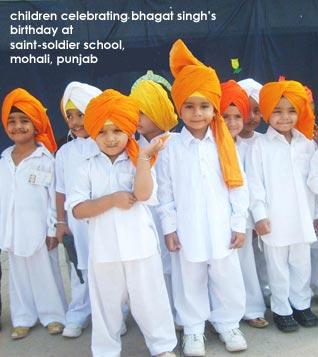Our Heroes
The Making of A Real Indian Hero
by ROOPINDER SINGH
Committed communicator, perceptive, passionate, admirable ... any young person would be flattered to be the subject of any one of these adjectives. What would happen if all of them, and many more, were used for the same person?
Well, he would be a legend - Shaheed.
The legacy of the man is such that his name sounds incomplete without this prefix.
Bhagat Singh, the freedom fighter, has been immortalised as martyr, so much so that we often forget to acknowledge the person who accomplished the feats that helped change the course of Indian history.
Was it his sacrifice alone that made Bhagat Singh great? No, not at all! There is much more to this man who did not get to celebrate his 24th birthday, but has left a robust and inspiring legacy recognised even 80 years after he was martyred, so much so that numerous political groups want to appropriate his legacy.
To understand Bhagat Singh is a difficult task. Though he did not live for long, as we journey through his brief life, we realise that it was the action-packed events around him that shaped Bhagat Singh's mind. Eventually, he was to have a tremendous effect on shaping history.
The Punjab, during the days of Bhagat Singh's childhood, was in turmoil. He was only 12-years-old when, on April 13, 1919, British Brigadier-General Reginald Dyer ordered his soldiers to open fire on an unarmed gathering of men, women and children at Jallianwala Bagh, Amritsar. The firing lasted about 10 minutes and 1,600 rounds were fired. Official sources placed the casualties at 379, others said the number was over 1,000, with more than 2,000 wounded. It is one of the most horrific events of British Indian history.
Although Bhagat Singh initially studied at District Board Primary School in Banga, Layalpur district, (Punjab, now in Pakistan), he later went to school at DAV High School, Lahore. It was regarded by the British as a "nursery of seditious activities".
Bhagat Singh was precocious, but not studious. He read a wide range of books, and was fluent in Urdu, and he used this language to write his first letter to his grandfather, Arjan Singh.
He was 14 when, on February 20, 1921, at Nankana Sahib, the birthplace of Guru Nanak, there was an incident that left a deep impact on him. Narain Das, who was the Hindu custodian of Nankana Sahib, and his men, fired on Akali protesters - [the custodian was widely known for defiling and desecrating the gurdwara, under the sponsorship of the British Raj.]
The massacre of the unarmed protesters was widely condemned, and an agitation was launched till the control of this historic gurdwara was restored to the Sikhs. Bhagat Singh served langar (food) to volunteers who passed through his village on their way to Nankana Sahib.
When he was 16, there came the Jaito Morcha of 1923, which was an Akali agitation for the restoration of Maharaja Ripudaman Singh of Nabha, who had strong nationalistic sympathies.
It was in this backdrop of unrest and the harsh coercive power of the British Raj, which was being used to quell legitimate protests, that Bhagat Singh, the martyr, was shaped. Often the youth are accused of being rudderless, but what is forgotten is that sometimes young people have a clear vision of what they see as their role in building the future, and single-mindedly work on it.
By the time he was 16, Bhagat Singh had made conscious choices about what he had to do with his life - he had decided to dedicate it to the cause of securing freedom for India. In doing so, he did not follow the constitutional approach of B.G. Gokhale and his supporters. Mahatma Gandhi's non-cooperation movement did not hold his interest for long.
For Bhagat Singh, his course lay in following a revolutionary course, even if it meant countering the violence of the mighty British Raj with violence.
In 1923, Bhagat Singh joined National College, Lahore, where he made a positive impression, academically. He was also a member of the college dramatics society. One of the very few pictures available of Bhagat Singh is a portrait of the members of dramatics club taken at National College in 1921-22. The picture features a young man, turbaned and bearded. By that time, he was fluent in Urdu, Hindi, Gurmukhi, English, and Sanskrit.
In the article, Why I am an Atheist, Bhagat Singh writes about his days at college: "Though a favourite with some professors and disliked by certain others, I was never an industrious or studious boy. I could not get any chance of indulging in such feelings as vanity. I was rather a boy with a shy nature, who had certain pessimistic dispositions about (my) future career."
Bhagat Singh won an essay competition organised by the Punjab Hindi Sahitya Sammelan in 1923. His essay, Punjab's Language and Script, quotes Punjabi literature and discusses the problems of the Punjab.
He joined the Hindustan Socialist Republican Association, and a year later, upon being pressurised by his family, which wanted him to get married, Bhagat Singh left his house in Lahore and went to Kanpur. In a note left behind for his father, Bhagat Singh said: "My life has been dedicated to the noblest cause, that of the freedom of the country. Therefore, there is no rest or worldly desire that can lure me now ..."
Bhagat Singh was arrested in 1927 on charges of association with the Kakori Train Robbery Case. He was also accused of being responsible for a bomb explosion at Lahore during the Dussehra fair. He was let off for good behaviour against a heavy security of Rs 60,000.
In September 1928, a meeting of various revolutionaries from across India was called in Delhi under the banner of the Kirti Kissan Party. Bhagat Singh was the secretary of the meet. His later revolutionary activities were carried out as a leader of this association.
Bhagat Singh and his compatriots killed a British police officer to avenge the death of Lala Lajpat Rai who succumbed to his injuries following a brutal beating by the police. Later, Bhagat Singh and Batukeshwar Dutt, another revolutionary, threw a bomb in the Central Assembly to protest against the Defence of India Act which gave more oppressive powers to the police.
They were arrested and imprisoned. Bhagat Singh used all his court appearances not to press for his acquittal or freedom but to espouse the cause of the freedom of the nation ... till the very last appearance, and, in fact, even beyond that.
Shaheed Bhagat Singh became an even more potent rallying point against the Raj than Bhagat Singh alive.
The slogan Inqalaab Zindabad that he had rallied under, as he lived the life of a revolutionary, was now substituted by another one - Bhagat Singh Zindabad.
Shaheed Bhagat Singh became too much of an icon - everyone wanted to adopt him. In the course of the decades that followed, the young man was appropriated by political groups that claimed him as their own - earlier, and even now, as we have recently seen in Punjab.
We should be grateful that Bhagat Singh wrote a fair deal and through his articles and diaries, we get glimpses of the mind of the man. The picture that emerges is of a person with an intellect and expression far beyond his years. He was well read, and a number of his letters from the Lahore Jail refer to books or request his friends to send him book and other reading material.
On March 23, 1931, Bhagat Singh, along with two colleagues - Rajguru and Sukhdev - was hanged in Lahore, Punjab.
He was a nationalist, a hero and a youth who became an icon. Even as political parties seek mileage by associating with his name, one cannot but help feeling that Bhagat Singh would have taken to task the pretenders who are not, by any stretch of imagination, as committed to ideals as he was.
A Brief but eventful life
Date of Birth: September 28, 1907.
Place of Birth: Chak No. 105, Banga village, Jaranwala Tehsil, Lyalpur district, Punjab (now in Pakistan).
Grandfather: Arjan Singh.
Father: Kishan Singh.
Mother: Vidyawati.
Siblings: Jagat Singh, Kulbir Singh, Kultar Singh, Rajinder Singh, Ranbir, Amar Kaur, Sumitra (Parkash Kaur), Shakuntla.
Education: Primary School, Banga, Lyalpur; DAV School, Lahore; National College, Lahore (passed FA and left while doing BA).
Historical highlights
1924: Left home and went to Kanpur to work with other revolutionary leaders.
1926: Established Naujwan Bharat Sabha, Lahore.
1928: December 17 - assassinated Saunders.
1929: April 8 - threw bomb in Central Legislative Assembly; was arrested.
1930: October 7 - Awarded death sentence by the Special Tribunal in Lahore.
1931: March 23 - Hanged till death at Central Jail, Lahore.
[Courtesy: Tribune]
March 23, 2011
Conversation about this article
1: Bibek Singh (Jersey City, U.S.A.), March 23, 2011, 12:25 PM.
A true hero! His articles/ writings depict his command over the subject and language. Unbelievable man! One fact that very few of us know - Bhagat Singh was inspired by Kartar Singh Sarabha and Bhai Randhir Singh ji... both Gaddarites.
2: Harinder Singh (San Antonio, Texas, U.S.A.), March 23, 2011, 7:29 PM.
Good article! A few years ago, debate on Bhagat Singh produced 4 films in a year; none did justice to him. S. Gurtej Singh co-authored a book on him which provided some perspectives grounded in history, not propaganda. I would have said the making of a 'real Punjabi hero' for, according to Bhagat Singh (as recorded by Bhai Randhir Singh) the Indians and The Tribune do not recognize the Sikh contributions from even back then. Ironical that this article appeared in The Tribune!
3: Jagjit Singh (Hong Kong), March 23, 2011, 11:49 PM.
Long live Bhagat Singh - and inspire our youngsters to be like him.
4: Hardeep Singh (Atlanta, Georgia, U.S.A.), March 24, 2011, 11:38 PM.
Another very critical battle fought by Sardar Bhagat Singh was to legalize the term 'Political Prisoner'. All the well-known and prominent leaders of the Indian Freedom Struggle were given affluent treatment but the average Indian freedom fighters, who were taking bullets on their chests had to face very poor hygenic and rigorous conditions in jail. Bhagat Singh made an effort to fight against it to earn respectable treatment for all the 'common' freedom fighter, but neither the Britsh nor the government of independent India conferred the status of 'Political Prisoner' - even after the Independence in 1947.
5: Baljit Singh Rihal, JP (London, United Kingdom), March 25, 2011, 6:02 AM.
Shaheed Bhagat Singh deserves better recognition by the Indian Government. His story needs to be taught in ALL schools in India, at par with Mohandas Gandhi.
6: H.S. Vachoa (U.S.A.), March 25, 2011, 3:21 PM.
Bhagat Singh was influenced by the "October Revolution", but was also like the Bolsheviks in that they never envisioned a Russia after the Czars, leading Russia from the frying pan into the fire. Although a man of determination, Bhagat Singh's goal was only to see British leave but he never envisioned India after the occupation of British. The British were not half as bad as the ones who were now usurping India. Bhagat Singh probably didn't realize that could happen.
7: Dr. H. K. Virik (Kuala Lumpur, Malaysia), March 26, 2011, 5:12 AM.
I was in Lahore the day Bhagat Singh was driven in a black maria [a police van used to transport prisoners] through the main road - 'Mall Road'. The wide avenue was packed with the public shouting slogans, and so was my mother. I was on the flat roof of a building where we were staying with friends, and saw everything. My mother was crying away. I was so frightened ... and all she kept on repeating was 'zaalim' - "The tyrants!" It was my introduction to politics and the cruelties it entailed - highlighted by Maaji sobbing non-stop. I never asked her the meaning of the word "zaalim". But it was obvious. It must have been the year he was sentenced, between 1929 and 1931. I was 7-8 years old. I had also skimmed through a book when I was about 10. I think it recorded the oral testimonies of those who survived the Jalliawala Bagh massacre in Amritsar. I have a difference of opinion with a local critic who said that black marias were not around then? Can any one shed any light on it?






